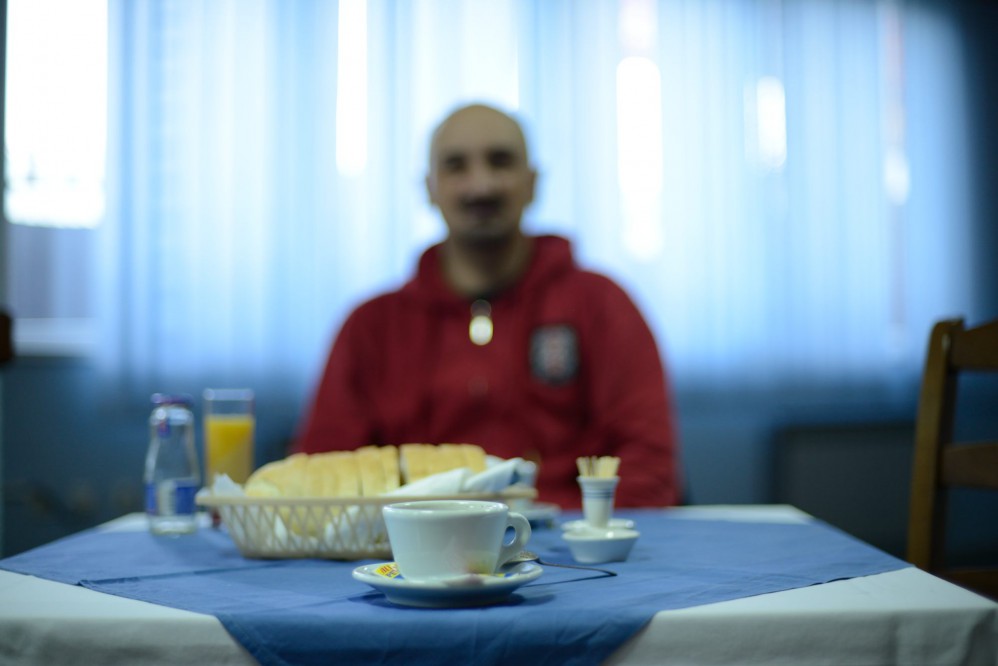In 2010, we at CNA decided to start documenting monuments from the last war in BiH, to photograph them and gather basic information about how they were created. Our decision was to also include sites of suffering that were not marked by a memorial. From 2012 to 2015, we went on field visits, photographed, gathered data, reviewed our collection and discussed next steps. The travelling and photographing was done by Nedžad Horozović and myself. This text provides an insight into a small portion of what we experienced that cannot be seamlessly included in an analysis of the culture of memory.
When all this was over, we remembered the breakfast under neon lighting, sitting alone in a spacious dining hall intended for wedding parties, the white tablecloth overlaid with a greasy blue one, a salt dish in the middle. The detached waiter brings our oil-soaked omelettes and Turkish coffees along with a basket of white bread.
We sit in our jackets, because that hall in the hotel is not worth heating, it is warm in the smoky cafe facing the town square with its central monument. It’s early, the town is deserted. We are glad that the hotel where we spent the night was not the site of a mass crime, the staff already know us, we have stayed there a few times.
Outside there is a whitish cover of frost. We drink our coffee waiting for our friend from the local veterans association to come and take us to the memorial room and on to the locations of the memorials and sites of suffering.
We follow him in silence, it’s too early for conversation, he unlocks the memorial room, we walk in and start photographing. In each of the connected rooms, I feel a sense of unease mixed in with the need to pay my respects to the loss that was suffered. We are surrounded by photographs of people who are no longer among the living. For some of them we get their abridged life stories, whatever fits into a minute of two, memories and anecdotes. My unease grows as I look over photos of politicians from the war period, next to trophies that take the form of parts of enemy uniforms. I think about those captured and killed soldiers from the other side, whose photographs I will perhaps see some day on some other wall. The pressure of senselessness and sorrow weighs heavily on me.
But we are accustomed to it, we have seen dozens of such places, Nedžad and me, we exchange mute glances and show one another the angles we discovered.
At each monument that we photograph, the rare passers-by stop and watch us, and our friend and guide steps in to explain. Even in the centre of town, the camera elicits suspicion, who are we, why are we there, why are we taking pictures? To our “Good day,” they reply with “God bless,” “As-Salaam Alaykum,” “Praise Jesus,” and a few shake our hand. Peace is with us, we would never berate Jesus, and if God decides to bless us, all the better. Still, most of all we hope for a good day. A good day would mean no one attacking us.
We photograph shacks with a billboard advertising “Sana” cattle feed on the outskirts of the city, some thirty meters away from the only landscaped green area in the village that used to be the site of a monument to the Partisans before the war, and has since become the site of an added monument commemorating the victims from the recent war. Victims from the community that makes up the majority of the population there today. On 7 May 1992, 16 detained civilians were killed in the adjacent shack. Twenty years later, there is no sign that would indicate what happened there, and we furtively and quickly take our photos because there is a bar near the shacks, and there are always drunks in a bar. We get into our car and drive away in silence, feeling humiliated and restricted. Everyone is uncomfortable, both Nedžad and me, and our host who sees the crime in Crkvina as a shameful stain, even though none of us are to blame. We do not try to dispel the uneasiness, we bear it calmly, it should be there, we must own it. The feeling of shame and pain brings us closer together. I almost left out the pain, one tends to grow numb.
Over almost three years of our intermittent travels to photograph monuments, in each place we visited, our hosts wanted to show us another site of suffering or monuments we had not known about. It was important for them to take us to see these places, and we went along and took pictures. Some of them were photographed, but we never managed to gather information about them.
During our last round of photographing, one of the last places we visited was Višegrad. We were received by the local imam who maintains the graveyard with the monument to killed Bosniaks from Višegrad. He talked to us for a long while, and then he took us to see the graveyard. There, I saw the grave of a child and I knelt on the grass to take a photo, and that scene has become imprinted in my mind. It keeps coming back to me in my dreams and waking life, I have cried over it many times, and for a long time, I would not show the photograph to anyone but my closest friends and family, unsure of whether it should be made public or not.
This is that photograph.  in Belgrade, 9 Noveber 2015
in Belgrade, 9 Noveber 2015
Nenad Vukosavljević
click the photo below to access the gallery with more photographs:
